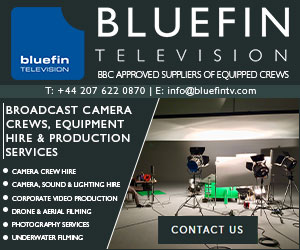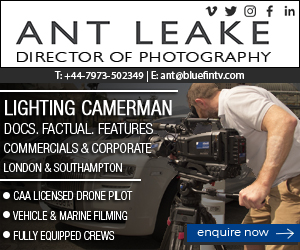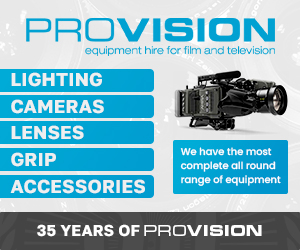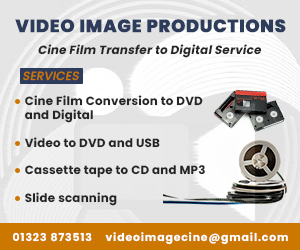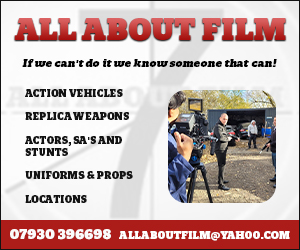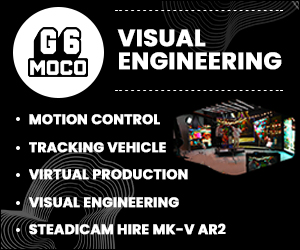Broadcast News
03/06/2016
Focusing On The Future Of UK Broadcasting

In many ways this is a perfect time for a cameraman or camerawoman to be in UK broadcasting, says Keith Massey, Chairman, Guild of Television Cameramen (GTC).
The quality of television production in the UK is at an all time high. With a decent aerial, the picture running through the cable, decoded through the latest UHD television sets and down-sampled to HD is simply stunning. The British public should realise they are in a golden era!
I check this statement with the caveat though that while television picture quality is stunning in many areas, this does not apply to all genres. Drama is leading the way as the cameras used on programmes such as Downton Abbey and The Night Manager are shot with the same digital cameras that are used to film cinema blockbusters like Star Wars at Pinewood Studios. Wildlife documentaries and Live shows like BGT, Strictly Come Dancing and sport are also world class.
Letting the side down for too long have been programmes in regional SD output and national factual under the watch of journalists. The senior management at the BBC must have been viewing programmes on a 14" screen as they allowed substandard material to be transmitted from the industrial cameras used by video journalists, assistant producers and runners which we, as freelance professionals, would not have been acceptable or tolerated by production, or hired again.
Now I go back a long way, and as a boy remember watching The Queen's Coronation in 1953 on a 9" black and white 405-line set as well as the early Attenborough Zoo Quest programmes. I was captivated with the world coming into my front room. My, how we have moved forward. It's unbelievable.
To get to where we are today we need to just go through a bit of history. Over the past 10 years there has been a revolution in the hardware by the manufacturers and particularly in the new cameras now on the market. There has been so much change that I am really struggling to remember all the incredible changes – but here are some. Ten years ago we were in Standard Definition at 720 x 576 lines and the boxy 4 x 3 ratio with the10-bit Sony DigiBeta as the de-facto 2/3" camera for top-end production in documentaries, features and drama. On the national and regional news and feature side, there was the 8-bit 1/4" DVCAM as the staple diet, made by Ikegami and Sony. Both these cameras were tape based.
Then all hell broke out as we changed to HD in 2006 at 1920 x 1080 and widescreen 16 x 9; continuing on tape with the Sony HDCAM, but the past few years onto cards. Panasonic brought out an excellent format with the 10-bit P2 family which was adopted by Sky News and ITV and capable of 100Mbps, while the BBC went for the 8-bit Sony PMW 350 (which was quickly changed to the 500 series due to a flash banding problem) XDCAM shooting at 35Mbps for news and 50Mbps for features. 35mm DSLR still cameras capable of video recording were then allowed, like the Canon 5D, Nikon D800, Panasonic Lumix and Sony A7S which are currently used mainly as second cameras. Canon also introduced a game changer with the C300 large sensor and also the compact HD spec 50 Mbps XF305 and 105 for specific projects.
And we mustn't forget the other essential connected revolution – the television sets. We can all remember the size and weight of the old tube 32" set that took up half the living room. The new flat LED screens, up to 70", bring good telly up to cinema standards and are now 4K even though we are not transmitting any programmes in that format.
The new wave of large sensor cameras have been taking over as the first choice for top end documentary and sport features, with an emphasis on shallow depth of field (i.e. the interviewee in sharp focus but the background soft – the bokeh) and is highly "fashionable" and the flavour of the month. The most popular are the Sony F5 and F55 which are "modular" and come as a computer style box and you then have options from the manufacturer to add a viewfinder and rigs to be able to handhold the camera or purchase from the myriad of third-party manufacturers who are all in this new wave. At the ultimate end of the scale, the renowned German manufacturer, ARRI probably dominates the market with the ALEXA and AMIRA cameras, as well as Sony and Ikegami.
I haven't mentioned the choice of new lenses to complement the cameras from a few hundred to tens of thousands of pounds. Although we can get the quality, I feel that with some of the camera designs have gone backwards as, in too many cases, the vital ergonomics have gone out of the window, with some models aptly described as "Frankensteins" (in the 16mm days one camera was marketed as a cat sitting on your shoulder). I have been somewhat disappointed with the BBC, who used to be the arbiter of quality, who would be the benchmark for the world, but who, in my opinion, have not led the way in the pursuit of excellence.
Then add to the equipment list the latest gizmos in the camera department armoury: drones, mini-cams and rigs, all aiming to add production value on the screen. The steadicam was a game-changer for the cinema when it was invented by Garrett Brown in 1975 but we now have a version made by the leading drone company, DGI, who make a stabilising unit, the Ronin, for use with DSLRs at a fraction of the cost.
Where does all this change leave the new style freelancer? Probably confused! The artistic capability of the cameraman is second to none and the expectation of production is now even more demanding. It's all very well having this amazing choice of toys from the cupboard but the only thing that hasn't changed is the human input. Unfortunately for production, cameramen and camerawomen still – very inconveniently – only have two arms, two legs and one head and they need sleep... but they are looking into this to see if we can be genetically modified!
All high-end documentaries now incorporate the use of drones which can be used to superb effect in setting the geography, in a 3D manner, where using a real helicopter would be far too dangerous or impossible – like flying inside a monastery for instance – though watching footage over water with a camera and drone costing several thousand pounds makes me very nervous. Then we have the mini-cams like the GoPro which has revolutionised filming the impossible. Many years ago I made two programmes on gliding and the only camera that was small enough to put inside and outside the cockpit was a World War 11 gun camera that took a 50ft 16mm magazine and lasted 1 min 20 seconds! This was challenging. With the GoPro you have HD and recording capabilities well over an hour and purpose built mounts for filming most sports.
The GTC (Guild of Television Cameramen) is now in its 46th year and throughout this period our guild has strived for our members to reflect the best of professional practices; to keep abreast of new innovations – some of which have been brought about with our co-operation and input with manufacturers like Vinten, and to offer workshops on every conceivable area of our work from surviving in extreme weather, operating drones, colour grading, studio and field cameras, lighting and dealing with digital workflows. Our membership is rising fast and its diversity increasing: we have seen many more camerawomen joining in recent years and also witnessed a pleasing rise in the number of student members. These are the future and we want to help them to learn in the right way from the hugely experienced craftsmen amongst our membership.
Drama still leads the way with good crewing as the cost of on-camera and behind-camera talent is so high that shortcuts cannot be taken, and on-set discipline still applies now just as it was decades ago. However, unfortunately, some genres have cut right back on personnel and yet production still expects the same results. In the past, on news, a sound recordist was the norm, as well as on documentaries, current affairs and factual. Camera and sound assistants would learn the craft on the job by working with different cameramen. A lighting technician (or "spark") were also part of the team. Now, it's very often just the cameraman who has to use two or three cameras on an interview, sort out the sound, lighting and on news look after the editing and satellite communications as well! The remuneration for all this responsibility and multiple skills does not seem to be reflected.
Most of this article is dealing with equipment, but let us get one thing straight. The most important factor is US! The cameraman and camerawoman. It's our individual human interpretation that is the critical factor in television and cinema programme making. Our eyes will see it totally differently to all our colleagues, this is what production are paying for. On all things photographic the manufacturers will make out that it's their kit that is the important thing and that it can somehow just do the work for you. Sorry, but, no! It's an important tool but we need to point it in the right direction and dictate what it does. We cannot be overtaken by robots.
Image: Training to preserve skills and pass on knowledge is key to the GTC's approach for helping protect standards in the future.
www.gtc.org.uk
(JP/LM)
The quality of television production in the UK is at an all time high. With a decent aerial, the picture running through the cable, decoded through the latest UHD television sets and down-sampled to HD is simply stunning. The British public should realise they are in a golden era!
I check this statement with the caveat though that while television picture quality is stunning in many areas, this does not apply to all genres. Drama is leading the way as the cameras used on programmes such as Downton Abbey and The Night Manager are shot with the same digital cameras that are used to film cinema blockbusters like Star Wars at Pinewood Studios. Wildlife documentaries and Live shows like BGT, Strictly Come Dancing and sport are also world class.
Letting the side down for too long have been programmes in regional SD output and national factual under the watch of journalists. The senior management at the BBC must have been viewing programmes on a 14" screen as they allowed substandard material to be transmitted from the industrial cameras used by video journalists, assistant producers and runners which we, as freelance professionals, would not have been acceptable or tolerated by production, or hired again.
Now I go back a long way, and as a boy remember watching The Queen's Coronation in 1953 on a 9" black and white 405-line set as well as the early Attenborough Zoo Quest programmes. I was captivated with the world coming into my front room. My, how we have moved forward. It's unbelievable.
To get to where we are today we need to just go through a bit of history. Over the past 10 years there has been a revolution in the hardware by the manufacturers and particularly in the new cameras now on the market. There has been so much change that I am really struggling to remember all the incredible changes – but here are some. Ten years ago we were in Standard Definition at 720 x 576 lines and the boxy 4 x 3 ratio with the10-bit Sony DigiBeta as the de-facto 2/3" camera for top-end production in documentaries, features and drama. On the national and regional news and feature side, there was the 8-bit 1/4" DVCAM as the staple diet, made by Ikegami and Sony. Both these cameras were tape based.
Then all hell broke out as we changed to HD in 2006 at 1920 x 1080 and widescreen 16 x 9; continuing on tape with the Sony HDCAM, but the past few years onto cards. Panasonic brought out an excellent format with the 10-bit P2 family which was adopted by Sky News and ITV and capable of 100Mbps, while the BBC went for the 8-bit Sony PMW 350 (which was quickly changed to the 500 series due to a flash banding problem) XDCAM shooting at 35Mbps for news and 50Mbps for features. 35mm DSLR still cameras capable of video recording were then allowed, like the Canon 5D, Nikon D800, Panasonic Lumix and Sony A7S which are currently used mainly as second cameras. Canon also introduced a game changer with the C300 large sensor and also the compact HD spec 50 Mbps XF305 and 105 for specific projects.
And we mustn't forget the other essential connected revolution – the television sets. We can all remember the size and weight of the old tube 32" set that took up half the living room. The new flat LED screens, up to 70", bring good telly up to cinema standards and are now 4K even though we are not transmitting any programmes in that format.
The new wave of large sensor cameras have been taking over as the first choice for top end documentary and sport features, with an emphasis on shallow depth of field (i.e. the interviewee in sharp focus but the background soft – the bokeh) and is highly "fashionable" and the flavour of the month. The most popular are the Sony F5 and F55 which are "modular" and come as a computer style box and you then have options from the manufacturer to add a viewfinder and rigs to be able to handhold the camera or purchase from the myriad of third-party manufacturers who are all in this new wave. At the ultimate end of the scale, the renowned German manufacturer, ARRI probably dominates the market with the ALEXA and AMIRA cameras, as well as Sony and Ikegami.
I haven't mentioned the choice of new lenses to complement the cameras from a few hundred to tens of thousands of pounds. Although we can get the quality, I feel that with some of the camera designs have gone backwards as, in too many cases, the vital ergonomics have gone out of the window, with some models aptly described as "Frankensteins" (in the 16mm days one camera was marketed as a cat sitting on your shoulder). I have been somewhat disappointed with the BBC, who used to be the arbiter of quality, who would be the benchmark for the world, but who, in my opinion, have not led the way in the pursuit of excellence.
Then add to the equipment list the latest gizmos in the camera department armoury: drones, mini-cams and rigs, all aiming to add production value on the screen. The steadicam was a game-changer for the cinema when it was invented by Garrett Brown in 1975 but we now have a version made by the leading drone company, DGI, who make a stabilising unit, the Ronin, for use with DSLRs at a fraction of the cost.
Where does all this change leave the new style freelancer? Probably confused! The artistic capability of the cameraman is second to none and the expectation of production is now even more demanding. It's all very well having this amazing choice of toys from the cupboard but the only thing that hasn't changed is the human input. Unfortunately for production, cameramen and camerawomen still – very inconveniently – only have two arms, two legs and one head and they need sleep... but they are looking into this to see if we can be genetically modified!
All high-end documentaries now incorporate the use of drones which can be used to superb effect in setting the geography, in a 3D manner, where using a real helicopter would be far too dangerous or impossible – like flying inside a monastery for instance – though watching footage over water with a camera and drone costing several thousand pounds makes me very nervous. Then we have the mini-cams like the GoPro which has revolutionised filming the impossible. Many years ago I made two programmes on gliding and the only camera that was small enough to put inside and outside the cockpit was a World War 11 gun camera that took a 50ft 16mm magazine and lasted 1 min 20 seconds! This was challenging. With the GoPro you have HD and recording capabilities well over an hour and purpose built mounts for filming most sports.
The GTC (Guild of Television Cameramen) is now in its 46th year and throughout this period our guild has strived for our members to reflect the best of professional practices; to keep abreast of new innovations – some of which have been brought about with our co-operation and input with manufacturers like Vinten, and to offer workshops on every conceivable area of our work from surviving in extreme weather, operating drones, colour grading, studio and field cameras, lighting and dealing with digital workflows. Our membership is rising fast and its diversity increasing: we have seen many more camerawomen joining in recent years and also witnessed a pleasing rise in the number of student members. These are the future and we want to help them to learn in the right way from the hugely experienced craftsmen amongst our membership.
Drama still leads the way with good crewing as the cost of on-camera and behind-camera talent is so high that shortcuts cannot be taken, and on-set discipline still applies now just as it was decades ago. However, unfortunately, some genres have cut right back on personnel and yet production still expects the same results. In the past, on news, a sound recordist was the norm, as well as on documentaries, current affairs and factual. Camera and sound assistants would learn the craft on the job by working with different cameramen. A lighting technician (or "spark") were also part of the team. Now, it's very often just the cameraman who has to use two or three cameras on an interview, sort out the sound, lighting and on news look after the editing and satellite communications as well! The remuneration for all this responsibility and multiple skills does not seem to be reflected.
Most of this article is dealing with equipment, but let us get one thing straight. The most important factor is US! The cameraman and camerawoman. It's our individual human interpretation that is the critical factor in television and cinema programme making. Our eyes will see it totally differently to all our colleagues, this is what production are paying for. On all things photographic the manufacturers will make out that it's their kit that is the important thing and that it can somehow just do the work for you. Sorry, but, no! It's an important tool but we need to point it in the right direction and dictate what it does. We cannot be overtaken by robots.
Image: Training to preserve skills and pass on knowledge is key to the GTC's approach for helping protect standards in the future.
www.gtc.org.uk
(JP/LM)
More Cameraman, Cameramen & Crew Stories
01/09/2016
Broadening Our Crew Networks
Over the summer I camera-operated on several jobs that consolidated my view that camera crews continually need to adapt their skills to take advantage
Broadening Our Crew Networks
Over the summer I camera-operated on several jobs that consolidated my view that camera crews continually need to adapt their skills to take advantage
23/06/2016
Broadcaster Uses Egripment's Xtreme T10 For Euro 2016 Coverage
The Xtreme T10 encoded telescopic crane from Egripment is being used by German broadcaster ARD & ZDF as part of its daily live broadcast from the UEFA
Broadcaster Uses Egripment's Xtreme T10 For Euro 2016 Coverage
The Xtreme T10 encoded telescopic crane from Egripment is being used by German broadcaster ARD & ZDF as part of its daily live broadcast from the UEFA
03/06/2016
Focusing On The Future Of UK Broadcasting
In many ways this is a perfect time for a cameraman or camerawoman to be in UK broadcasting, says Keith Massey, Chairman, Guild of Television Camerame
Focusing On The Future Of UK Broadcasting
In many ways this is a perfect time for a cameraman or camerawoman to be in UK broadcasting, says Keith Massey, Chairman, Guild of Television Camerame
02/06/2016
Focus On The Future For Cameramen
To get an idea of the future for cameramen & women you need to look to the past, writes Sean Russell, Freelance Lighting Cameraman. Art and artists ha
Focus On The Future For Cameramen
To get an idea of the future for cameramen & women you need to look to the past, writes Sean Russell, Freelance Lighting Cameraman. Art and artists ha
13/01/2016
Cameraman Secrets: Practice Makes (Perfect) Unfazed...
It's not all about the camera. Of course, I could discuss the merits of using one format over another for days, but instead I'd like to talk about the
Cameraman Secrets: Practice Makes (Perfect) Unfazed...
It's not all about the camera. Of course, I could discuss the merits of using one format over another for days, but instead I'd like to talk about the
16/06/2015
Cinematographer Abraham Chooses Miller Camera Support
When internationally award-winning Australian cinematographer Abraham Joffe set out to document the lives of five world-class photographers as they ca
Cinematographer Abraham Chooses Miller Camera Support
When internationally award-winning Australian cinematographer Abraham Joffe set out to document the lives of five world-class photographers as they ca





